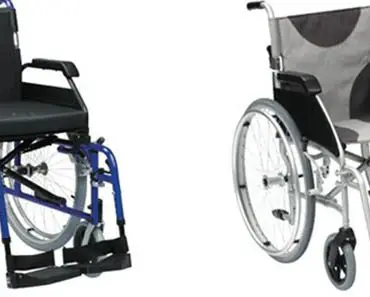It’s sometimes hard to make a final choice in a rich market. This concerns the market for walking aids, as well. Moreover – when it comes to crutches, which represent the biggest share of this market – consumers might eventually get totally confused about what exactly they need.
And after all, what they need is nothing else, but convenience while having a long-lasting, short or undetermined rehabilitation process to experience. If you are about to use crutches to recover from a trauma or to support your everyday lifestyle after surgery, you might be now wondering, then, which one to pick: forearm crutches or underarm crutches.
Are forearm crutches totally different from underarm crutches?

Well, in general, they are both types of crutches. And in most cases, both of these types are compatible with almost any diagnosis or rehabilitation plan. Hence, there are specific medical conditions that require either forearm or underarm crutches only.
Sometimes, manufacturers even produce their forearm and underarm crutches in the completely same design. This might be very confusing and even frustrating for those patients who have never faced the situation to make such a purchase.
And if this is your first walking aid to buy, a similar design might seem to you as similar functionality, too.
On the other side, generally, we would say forearm crutches come with completely different pros and cons in comparison to the underarm crutches. Although you will find hundreds of discussions regarding the advantage of the forearm or the underarm type, it’s hard to say that one of them is 100% the best choice to make.
That’s why it’s important for anyone, who is about to select a pair of crutches, to take under considerations both – the pros and the cons when it comes to both of these crutch types.
What we are going to do, though, is not to list you some advantages, but instead, will pay attention to each feature the perfect crutches should have in order to check out if any of these two general crutch types possess it.
When it comes to using crutches, balance is everything!
That’s why it’s logical for any patient to ask: which crutch type does bring more opportunities to learn how to keep balance faster, as well as to restore it if during the last couple of days you have been struggling to learn how to achieve it? Let’s answer this question right away!

Let’s start with the fact that if ordinarily, you are able to keep balance, even with trauma, you will eventually learn to be balanced on your crutches, too – regardless whether you use forearm or underarm crutches. You will just need some time to practice and to adjust your crutches.

However, if you are not a balanced type, then you should consider which crutches would help you cope with the problem. Underarm crutches will suit you better if you do not have a good balance in your body. It is easier to make a balance and coordination while using underarm crutches. It requires more practice to master forearm crutches, no doubts.
Which crutches are better for more flexibility?
Flexibility usually means no or at least minimum limits in movements when it comes to wearing crutches alongside with your lady’s bag. The truth is that if you are about to continue your normal lifestyle and it’s quite dynamic, the flexibility is supposed to be a top priority for your final choice.
In this case, we, on the contrary, this time, would recommend you to get a pair of forearm crutches. Experts claim that underarm crutches restrict your movements with up to 45% more than the forearm crutches do.

You can have different gaits in different terrains while using forearm or elbow crutches. If you can balance yourself with forearm crutches then you can enjoy the freedom of movement without tiring yourself much.
Which type of crutches is better for passing the stairs?
Speaking of which, climbing up and down the stairs is another thing you should take under consideration! Well, in this case, once again, the forearm crutches are going to be more suitable for you.
If you live in a place where stairs are constant obstacles on your way, forget about underarm crutches. You are going to get tired of them very soon.
Of course, this shouldn’t mean on mandatory that underarm crutches are completely impossible to be used to climb up or down the stairs. If you are more flexible in general and you are more of a sport type, they are going to suit your needs, too.
Keeping my upper body part strong – which crutches are better?
The question is almost equally asked that way – what if I am not that strong and in this case which crutches are better for me?
In all cases, you don’t feel strong enough or if you have suffered lots of interventions, including on the upper part of your body, you should go for that crutch type that will not burden your arms, neck, and back with additional efforts.

Besides doing your regular exercising routine plan from the general rehabilitation program you are prescribed to follow by a specialist, you should also buy yourself a pair of underarm crutches. It’s because they are more just in distributing the weight as compared to the forearm crutches.
However, even if you do have underarm crutches, don’t forget that all crutch types require some solid body strength. Still, if you feel very weak, it’s better to go for the underarm crutches as they are capable to assist you when walking.
Forearm crutches need you to have strength in your arms and core muscles (abdominal and pelvic region muscles).
Which crutch type to select if I should keep my posture in the correct position?
First of all, no matter what walking aid you use, you are going to be told by your therapist to constantly pay attention to your body posture. No matter what you have by your side for some support, always think about the body position and make sure to keep it straight.
Still, forearm crutches are better in keeping the posture in a correct position than underarm crutches. To be more specific, with forearm crutches, the whole posture straightening task gets easier.

The thing is that the forearm crutches faultlessly and naturally encourage the patient to stand tall and straight.
Meanwhile, you might be told even in the hospital or right in the store for walking aids that is has been always simple to walk with forearm crutches if your posture is good. That is why if you select them for your walking aid, you might expect an instant improvement of your body posture as an extra to your overall rehabilitation process.
Which crutches come with fewer side effects?
They say, prevention is the best cure and we do agree with this statement. That’s why it’s truly wise to consider what type of crutches to buy depending on the side effects each of them can bring you.
In this situation of comparison, we should say that forearm crutches represent the better option if you are prescribed to use crutches for a long period. The thing is that the forearm crutches are possible to cause you permanent nerve damage or a condition medically referred to as crutch palsy.

There’s something else that is not cool about the underarm crutches. They usually need underarm pads to be installed as without them you will eventually suffer from severe arm ache. Dermatology issues are possible, too – such as skin irritation or bruises.
Meanwhile, forearm crutches are better in distributing weight equitably to the whole upper body. That’s why there’s a total myth in the world that in general, forearm crutches are the better option.
They, indeed, seem to be more comfortable from the very first day you taste both of the types.
Never forget that choosing the right type of crutches is an individual decision!
Once you realize that and you start looking for the ideal pair of crutches especially for you (without being pressed by any subjective opinions) you will open your eyes for the most suitable type of walking aid for you. Always consider your own physical condition, as well as your individual diagnosis or medical plan for rehabilitation.
We would like to remind you that this material has only an informative purpose and it has not been written by a medical person. Don’t forget to discuss your recovery or your crutch selection with your therapist.






